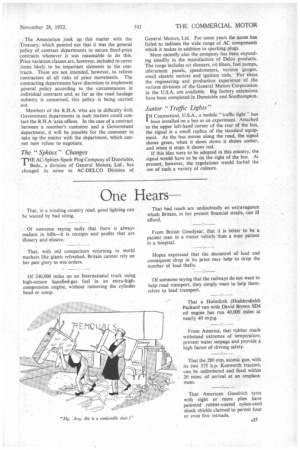One Hears
Page 29

If you've noticed an error in this article please click here to report it so we can fix it.
• That, in a winding country road, good lighting can be wasted by bad siting.
Of someone saying sadly that there is always realism in bills—it is receipts and profits that are illusory and elusive.
That, with old competitors returning to world markets like giants refreshed, Britain cannot rely on her past glory to win orders.
Of 240,000 miles on an International truck using high-octane liquefied-gas fuel in an extra-highcompression engine, without removing the cylinder head or sump. That bad roads are undoubtedly an extravagance which Britain, in her present financial straits, can ill afford.
From British Goodyear, that it Is better to be a patient_ man in a motor vehicle than a man patient in a hospital.
Hopes expressed that the decontrol of lead and consequent drop in its price may helpto drop the number of lead thefts.
Of someone saying that the railways do not want to help road transport, they simply want to help themselves to load transport.
That a Holmfirth (Huddersfield) Packard van with David Brown SD4 oil engine has run 40,000 miles at nearly 40 m.p.g.
From America, that rubber roads withstand extremes of temperature, prevent water seepage and provide a• high factor of driving safety.
That the 280 mm. atomic gun, with its two 375 h.p. Kenworth tractors, can be unlimbered and fired within 20 mins. of arrival at an emplacement.
That American Goodrich tyres with eight or more plies have patented rubber-coated nylon-cord shock shields claimed to permit four or even five retreads.




















































































